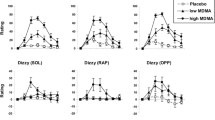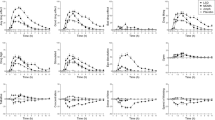Abstract
The effects of oral d-amphetamine and secobarbital and smoked marijuana on human social conversation and preference for socializing were studied in three separate experiments. During experimental sessions, active drug or placebo was administered using an acute or divided dosing procedure. Subjects who received drug then engaged in a discrete-trial choice procedure in which they made a series of mutually exclusive choices between a social (talking with their nondrugged partner) and nonsocial (sitting quietly alone) option. Lapel microphones and voice operated relays measured seconds of speech. Subjects engaged in greater amounts of conversation and chose the social option more frequently following acute dosing of d-amphetamine and secobarbital compared with placebo. Acute administration of marijuana did not significantly affect social speech or choice behavior, producing slight decreases in both measures. Acute dosing of all drugs significantly increased subjective drug effect or drug high; however, only secobarbital affected the circular lights task, producing significant performance decrements. The shifts in preference toward the social option observed with d-amphetamine and secobarbital suggest that these drugs increased the reinforcing effects of socializing relative to sitting alone. This may be one mechanism by which psychoactive drugs facilitate social conversation.
Similar content being viewed by others
References
Babor TF, Mendelson JH, Gallant BA, Kuehnle JC (1978a) Interpersonal behavior in group discussion during marijuana intoxication. Int J Addict 13:89–102
Babor TF, Mendelson JH, Uhly B, Kuehnle JC (1978b) Social effects of marijuana use in a recreational setting. Int J Addict 13:947–959
Babor TF, Berglas S, Mendelson JH, Ellingboe J, Miller K (1983) Alcohol, affect, and the disinhibition of verbal behavior. Psychopharmacology 80:53–60
Chait LD, Uhlenhuth EH, Johanson CE (1987) Reinforcing and subjective effects of several anorectics in normal human volunteers. J Pharmacol Exp Ther 242:777–783
Docter RF, Bernal ME (1964) Immediate and prolonged psychophysiological effects of sustained alcohol intake in alcoholics. Q J Stud Alcohol 25:438–450
Feldstein S, Weingartner H (1981) Speech and psychopharmacology. In: Darby JK (ed) Speech evaluation in psychiatry. Grune Stratton, New York, pp 369–396
Foltin RW, Fischman MW (1988) Effects of smoked marijuana on human social behavior in small groups. Pharmacol Biochem Behav 30:539–541
Foltin RW, Brady JV, Fischman MW, Emurian CS, Dominitz J (1987) Effects of smoked marijuana on social interaction in small groups. Drug Alcohol Depend 20:87–93
Griffiths R, Bigelow G, Liebson I (1974) Assessment of effects of ethanol self-administration on social interactions in alcoholics. Psychopharmacologia 38:105–110
Griffiths RR, Bigelow GE, Liebson I (1975) Effects of ethanol self administration on choice behavior: money vs. socializing. Pharmacol Biochem Behav 3:443–446
Griffiths RR, Wurster RM, Brady JV (1976) Discrete-trial choice procedure: effects of naloxone and methadone on choice between food and heroin. Pharmacol Rev 27:357–365
Griffiths RR, Stitzer M, Corker K, Bigelow GE, Liebson I (1977) Drug produced changes in human social behavior: Facilitation by d-amphetamine. Pharmacol Biochem Behav 7:365–372
Griffiths RR, Bigelow GE, Liebson I (1983) Differential effects of diazepam and pentobarbital on mood and behavior. Arch Gen Psychiatry 40:865–873
Heishman SJ, Stitzer ML, Bigelow GE (1988) Alcohol and marijuana: Comparative dose-effect in humans. Pharmacol Biochem Behav 31:649–655
Higgins ST, Stitzer ML (1986) Acute marijuana effects on social conversation. Psychopharmacology 89:234–238
Higgins ST, Stitzer ML (1988a) Effects of alcohol on speaking in isolated humans. Psychopharmacology 95:189–194
Higgins ST, Stitzer ML (1988b) Time allocation in a concurrent schedule of social interaction and monetary reinforcement: effects of d-amphetamine. Pharmacol Biochem Behav 31:227–231
Johanson CE, Schuster CR (1975) A choice procedure for comparing drug reinforcers: cocaine and methylphenidate in the rhesus monkey. J Pharmacol Exp Ther 193:676–688
Katz JL (1982) Effects of drugs on stimulus control of behavior. I. Independent assessment of effects on response rates and stimulus control. J Pharmacol Exp Ther 223:617–623
Katz JL (1983) Effects of drugs on stimulus control of behavior. II. Degree of stimulus control as a determinant of effect. J Pharmacol Exp Ther 226:756–763
Katz JL (1988) Effects of drugs on stimulus control of behavior. III. Analysis of effects of pentobarbital and d-amphetamine. J Pharmacol Exp Ther 246:76–83
McNair DM, Lorr M, Droppleman LF (1971) Profile of Mood States (Manual). Educational and Industrial Testing Service, San Diego
Perez-Reyes M, Di Guiseppi S, Davis KH, Schindler VH, Cook CE (1982) Comparison of effects of marijuana cigarettes of three different potencies. Clin Pharmacol Ther 31:617–624
Reiss D, Salzman C (1973) Resilience of family process. Arch Gen Psychiatry 28:425–433
Samson HH, Fromme K (1984) Social drinking in a simulated tavern: an experimental analysis. Drug Alcohol Depend 14:141–163
Smith RC, Parker ES, Noble EP (1975) Alcohol's effect on some formal aspects of verbal social communication. Arch Gen Psychiatry 32:1394–1398
Stitzer ML, Griffiths RR, Liebson I (1978) Effects of d-amphetamine on speaking in isolated humans. Pharmacol Biochem Behav 9:57–63
Stitzer ML, Griffiths RR, Bigelow GE, Liebson I (1981a) Human social conversation: effects of ethanol, secobarbital and chlorpromazine. Pharmacol Biochem Behav 14:353–360
Stitzer ML, Griffiths RR, Bigelow GE, Liebson I (1981b) Social stimulus factors in drug effects in human subjects. In: Thompson T, Johanson CE (ededs) Behavioral pharmacology of human drug dependence. NIDA Research Monograph 37, US Department of Health and Human Service, DHHS Publication No. (ADM) 81-1137, pp 130–154
Stitzer ML, McCaul ME, Bigelow GE, Liebson IA (1984) Hydromorphone effects on human conversational speech. Psychopharmacology 84:402–404
Thornton CC, Alterman AI, Skoloda TE, Gottheil E (1976) Drinking and socializing in “introverted” and “extroverted” alcoholics. Ann NY Acad Sci 273:481–487
Waskow IE (1967) The effects of drugs on speech: a review. In: Salzinger K, Salzinger S (eds) Research in verbal behavior and some neurophysiological implications. Academic Press, New York, pp 356–381
Author information
Authors and Affiliations
Rights and permissions
About this article
Cite this article
Heishman, S.J., Stitzer, M.L. Effect of d-amphetamine, secobarbital, and marijuana on choice behavior: social versus nonsocial options. Psychopharmacology 99, 156–162 (1989). https://doi.org/10.1007/BF00442801
Received:
Accepted:
Issue Date:
DOI: https://doi.org/10.1007/BF00442801




